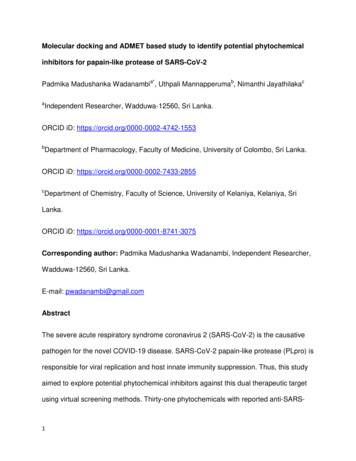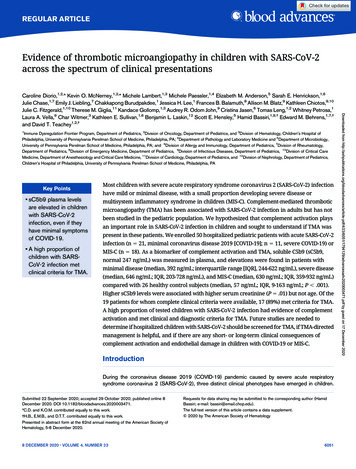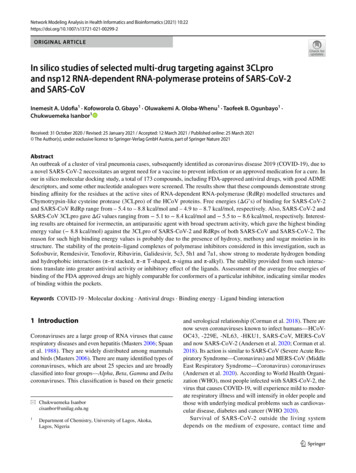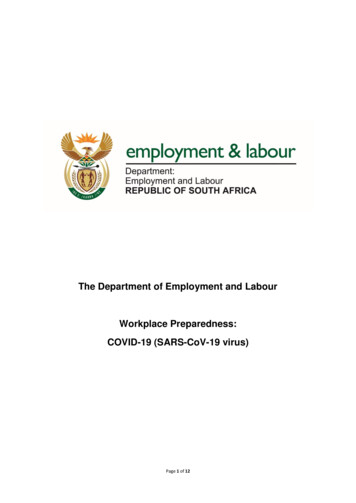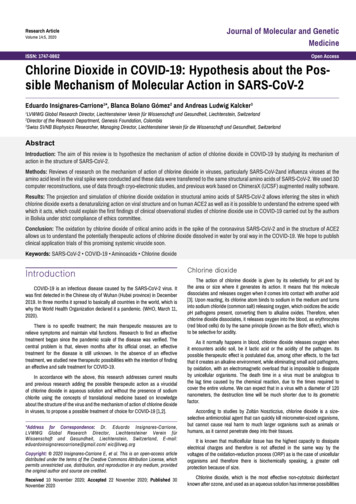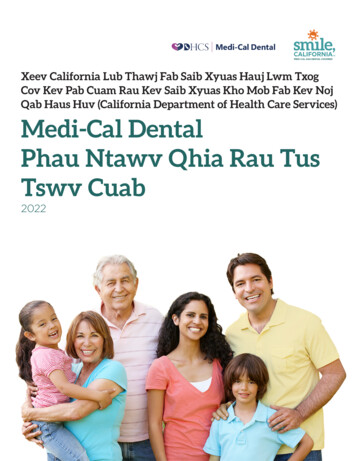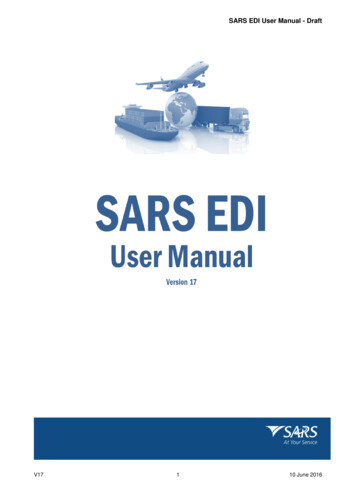
Transcription
California SARS-CoV-2Pandemic Crisis CareGuidelinesCONCEPT OF OPERATIONSHEALTH CARE FACILITY SURGE OPERATIONS AND CRISIS CARE06/2020
ContentsDisclaimer3Introduction3Care Continuum4Key Points about Crisis Care5Roles and Responsibilities6Planning and Implementation6Indicators and Triggers6Supply Management7Core Strategies8Acute Care Hospitals8Non-Acute Care Facilities and Services9Health Care Staff Engagement10Exercises10Integration with System Partners, MHOACs and RDMHCs11Public Engagement Transparency12Response12Triage12Ethical Considerations15Surge Capacity17Conclusion19Appendix A: Approach to Ventilator Management20Appendix B: Pandemic Patient Care Strategies for Scarce Resource Situations 30Appendix C: Acknowledgments
DISCLAIMERThe information contained in this document is meant to provide useful information tohealth care facilities and systems, but does not in any way alter or diminish health carefacilities’ and systems’ responsibilities during catastrophic public health events. Healthcare facilities or systems implementing these strategies in crisis situations shouldassure communication and coordination with their Health Care Coalition (HCC)partners, their Medical and Health Operational Area Coordinator (MHOAC), RegionalDisaster Medical and Health Specialist (RDMHS), the California Department of PublicHealth (CDPH), Emergency Medical System Authority (EMSA), and public safetypartners to assure the invocation of appropriate legal and regulatory protections asappropriate in accord with state and federal laws. Recommendations within thisdocument may be superseded by incident specific recommendations by CDPH. Weblinks and resources listed are provided as examples and their listing does not implyendorsement by CDPH.IntroductionThis document is a framework designed to help health care facilities plan for theCOVID-19 pandemic, which may cause overwhelming medical surge. This guidanceassumes incident management and incident command practices are implemented andkey personnel are familiar with healthcare emergency management planning andprocesses that underlie scarce resource decision-making.During a catastrophic public health event that results in medical surge, each healthcare facility or health care system should use this guidance as a framework todetermine the most appropriate steps and actions for their entity based on theirenvironment, hazards, and resources. Since pre-planned actions are always preferredto impromptu decisions, pre-event emergency management planning and training isrecommended. This document addresses common categories of health care delivery,triage, staff and space that could arise when available resources are limited orinsufficient to meet the medical needs of patients. In California, local or regional HCCs,hospitals and health care systems may determine additional issues and strategies inaddition to those outlined in this document.This document provides an overview of surge capacity and crisis care operationalconsiderations for health care facilities with an emphasis on hospitals for the State ofCalifornia. In addition to this framework, hospitals and health care systems areencouraged to review federal guidance which can be found on the National Academiesof Science webpage.This document is meant to provide information to support regional or county healthentities, including health departments as well as individual health care facilityoperations, as they develop and implement their operational plans. It is theresponsibility of the regional entity or the facility to work with their management teamand medical staff to ensure operational plans are in place. This document does notreplace the judgment of the regional health care facilities’ operational management,medical directors, their legal advisors or clinical staff and consideration of otherrelevant variables and options during an event. States and national medicalPage 3 of 38
organizations have shared best practices and incorporated relevant medical literaturein developing Crisis Care guidelines. California is using this collaborative work as acornerstone for these guidelines.California is committed to achieving and sustaining a California for All and to its nationleading laws and policies, including prohibiting discrimination on such protected basesas, age, disability, race, sex, gender identity and sexual orientation and immigrationstatus.This document is consistent with the “Guidance Relating to Non-Discrimination inMedical Treatment for Novel Coronavirus 2019 (COVID-19)” issued on March 30, 2020.Care ContinuumMost health care facilities are familiar with the concepts of surge capacity, the ability tomanage a sudden influx of patients1 and surge capability, the ability to manage patientsrequiring very specialized medical care.2 During conventional care, customary routineservices are provided through standard operating procedures. During contingency care,care provided is functionally equivalent to routine care but equipment, medications, andeven staff may be used for a different purpose or in a different manner than typical dailyuse (e.g. substituting one antibiotic for another that covers the same classification). Thedemands of most incidents can be met with conventional and contingency care. Crisiscare falls at the far end of the spectrum when resources are scarce and the focuschanges from delivering individual patient care to delivering the best care for the patientpopulation.The goal during a medical surge event is to maximize surge capacity strategies thatmitigate the crisis while minimizing the risks associated with deviations fromconventional care. Choosing the strategies that are most appropriate to the situationand pose the least risk to the patient and provider first, and then proceeding to riskierstrategies as demand increases and options decrease, is the preferred path.Surge capacity is described across a spectrum of three categories (Figure 1): Conventional: Usual resources and level of care provided.3 For example, duringa surge in patients, maximizing bed occupancy and calling in additional staff toassist. Contingency: Provision of functionally equivalent care that may incur a smallrisk to patients. Care provided is adapted from usual practices. For example,boarding critical care patients in post-anesthesia care areas using lesstraditional, but appropriate resources.4 Crisis: Disaster strategies used when demand forces choices that pose asignificant risk to patients but is the best that can be offered under thecircumstances. For example, cot-based care, severe staffing restrictions, orrestrictions on use of certain medications or other resources.51,2 ASPR. 2017-2022 Health Care Preparedness and Response Capabilities. pg. 443 Hick, J. L. Hanfling, D. & Cantrill, S. V. (2012). Allocating Scarce Resources in Disasters: Emergency Department Principles.Annals of Emergency Medicine, 59(3), p 178.4 Hick, J. L. Hanfling, D. & Cantrill, S. V. (2012). Allocating Scarce Resources in Disasters: Emergency Department Principles.Annals of Emergency Medicine, 59(3), p 178.5 Hick, J. L. Hanfling, D. & Cantrill, S. V. (2012). Allocating Scarce Resources in Disasters: Emergency Department Principles.Annals of Emergency Medicine, 59(3), p 178.Page 4 of 38
Figure 1: Examples of Changes in Health Delivery (modified from IOM)Key Points about Crisis Care Crisis care is not a separate triage plan. These strategies are extensions ofsurge-capacity plans. Crisis care may occur during long-term events such as pandemics whenresource constraints are likely to persist for long periods of time, or during shortterm, no-notice events where help will arrive, but too late to solve an acuteresource shortfall. Health care facilities will not have an option to defer caring for patients in a crisis.Demand, guided by ethics, will drive the choices that have to be made. Healthcare decisions, including allocation of scarce resources, cannot be basedon age, race, disability (including weight-related disabilities and chronic medicalconditions), gender, sexual orientation, gender identity, ethnicity (includingnational origin and language spoken), ability to pay, weight/size, socioeconomicstatus, insurance status, perceived self-worth, perceived quality of life,immigration status, incarceration status, homelessness, or past or future use ofresources. If strategies are not planned for ahead of time, they might not be consideredand/or will be difficult to implement. Strategies should be proportional to the resources available. As more resourcesarrive, you should move back toward strategies that are less demand driven(and therefore, back toward contingency and eventually conventional status)The principles of crisis care must be integrated into Emergency OperationsPlans (EOPs) at all levels of health care.Page 5 of 38
Roles and ResponsibilitiesThe primary focus of this guidance is on the operational strategies for health carefacilities during crisis. Health care facilities should be supported by regional HCCs, theirMHOAC, RDMHS, CDPH, EMSA, and public safety partners, local EMSA, and stateand local government agencies. HCCs includes partnerships between local publichealth, emergency medical services (EMS), health care facilities, and emergencymanagement that provide planning and response coordination.Planning and ImplementationIndicators and TriggersAn indicator is a “measurement or predictor of change in demand for health careservices or availability of resources.”6 An example of an indicator is a report of severalconfirmed cases of COVID-19 in the community by the local health department. Atrigger is a “decision point about adaptations to health care service delivery” thatrequires specific action.7 An indicator may identify the need to transition to contingencyor crisis care (but requires analysis to determine appropriate actions), while a triggerevent dictates action is needed to adapt health care delivery and resources. It isimportant for organizations to identify indicators and triggers prior to an event due tothe “stress, complexity, and uncertainty inherent in a crisis situation.”8There are two types of triggers – scripted and non-scripted. Build scripted triggers intostandard operating procedures, which are automatic ‘if/then’ decisions. Wheneverpossible, scripted triggers should be developed for frontline personnel (point of entryhealth care facility staff, reception, etc.) so they have actions they can take immediatelyto prevent delay. An example may be isolation protocols for individuals showing certainsigns or symptoms of a particular disease.Non-scripted triggers require additional analysis involving supervisory staff. These areoften part of an incident action planning cycle. The less specific the informationavailable, the more difficult it is to apply a scripted trigger and the more likely anexperienced supervisor or subject matter expert should be involved to process theinformation and decide on necessary actions. Frontline personnel should have a lowthreshold for passing indicator information along to supervisors for situationalawareness and potential decision-making.In addition to identifying response specific indicators and triggers, hospitals shoulddetermine the trigger or threshold to identify when they are in crisis care wheneverpossible. For example, if a hospital is providing cot-based care or any intensive careunit (ICU) care is provided outside usual intermediate and pre/post op areas, these areindicators that operations are now into crisis care and should trigger a response action.6Dan Hanfling, John Hick, and Clare Stroud, Editors; Committee on Crisis Standards of Care: A Toolkit for indicators and Triggers;Board on Health Sciences Policy; Institute of Medicine, “Crisis Standards of Care: A Toolkit for Indicators and Triggers” (the NationalAcademies Press, 2013) 27Ibid8 lbidPage 6 of 38
These triggers will vary by facility depending on size and resources. Facility levelindicators and triggers should be communicated with health care coalition partners,MHOACs and RDMHSs.Detailed information on indicators and triggers (including templates for health carefacilities) is available in the 2013 IOM/NAM Crisis Standards of Care: A Toolkit forIndicators and Triggers.How to identify and incorporate Indicators and Triggers in your EOP1.2.3.4.5.Do not focus on indicators and triggers in isolation.Determine what response strategies or options you may use during a disaster.Determine what indicators might be available during a disaster that wouldtrigger hospital action.Identify trigger points for your health care facility including, but not limited to:a.Implementing triageb. Temporarily closing your facility to new admissions or transfersc.Canceling elective proceduresd. Stockpiling or ordering more suppliese. Implementing staffing changesDetermine what staff actions should happen based on the indicator. Theseshould be specific and tell staff exactly when they should take certain actions.This is critical to the success of the response.Having specific actions staff should take at a clearly defined trigger is critical tothe success of the response. Delays in decision-making occur in unfamiliarsituations and with unclear authority.Supply ManagementHealthcare facilities are expected to anticipate supply needs and make every effort toprocure in advance supplies through usual supply chains and standing vendorcontracts. In addition, when resources are scarce, facilities must continue aggressivemeasures to acquire needed equipment such as ventilators. Such measures caninclude coordination with healthcare coalition partners and local reserves that mayprovide a source of supplies otherwise in shortageWhen usual supply chain sources are exhausted, supply resource requests can bemade through the local MHOAC, who in turn will attempt to fill these requests throughregional and state level stores of supplies and various procurement capability.During declared disasters CDPH and the state EMS authorities track health careresources including hospital med/surge and ICU surge capacity and ventilators, and willhelp coordinate the allocation and distribution or re-distribution of those scarceresources when available.Systems are also encouraged in times of scarce resources to explore alternatives toPage 7 of 38
single-use invasive ventilation by gathering data on the utility and safety of non-invasiveventilation and to investigate the efficacy and safety of splitting ventilators.Core StrategiesSix core strategies can be employed in anticipation of a shortage of space, supplies,and/or staff. These strategies can help avoid or mitigate a crisis of care situation. Whenwriting an EOP consider how your facility will utilize these strategies: Prepare: pre-event actions taken to minimize resource scarcity (e.g. stockpilingof personal protective equipment (PPE), medications or supplies, planning,training). Substitute: use an equivalent device, drug, or personnel for one that wouldusually be available (e.g. exchanging morphine for fentanyl). Adapt: use a device, drug, or personnel that are not equivalent but that willprovide sufficient care (e.g. anesthesia machine for mechanical ventilation;licensed practical nurse (LPN) with registered nurse (RN) supervision instead ofmultiple RNs). Conserve: use less of a resource by lowering dosage or changing utilizationpractices (e.g. minimizing use of oxygen driven nebulizers to conserve oxygen). Re-use: re-use (after appropriate disinfection/sterilization) items that wouldnormally be single-use items. Re-allocate: restrict or prioritize use of resources to those patients who arelikely to benefit and survive in the immediate short-term or to those with greaterneed only in times of actual shortage.Acute Care Hospitals1.2.3.4.5.Review available resources and determine potential strategies to addressCrisis Care Guidelines across the surge capacity continuum from conventionalto crisis care.Review your hospital’s capabilities in managing surge, critical care, infectiousdisease, isolation, just-in-time training, and pediatrics to meet their objectives.a. Involve in this review: nursing, administration, emergency management,emergency services, ancillary and support services—lab, radiology,respiratory therapy, pharmacy, facilities etc.—and physician personnel.b. Include critical care if your institution provides those specialties.Determine what number of pandemic patients should be planned for based onsuspected hazards. Consider your role in the community and the presence orabsence of other health care facilities in the area.Incorporate indicators and triggers (surge capacity information throughout thecare continuum) into your EOP.This should also include the notifications to supervisors and partner agenciesthat need to occur when these triggers are activated. Delegating authority toactivate the disaster plan to emergency department (ED) staff or nursingsupervisors/charge nurses should be done when possible to facilitate rapidaction. The adoption of clear policies helps facilitate decisions as well asprovides accountability. Education and training of staff should be conducted toassure successful implementation of the plan.a. Keep in mind the training practice of educating to an awareness,Page 8 of 38
6.7.8.knowledge, and proficiency level. Not all staff members need to beproficient in the plan, but those frontline decision-makers (chargenurses, unit supervisors etc.) should know how to incorporate surgecapacity into their respective units prior to an incident. See below formore detail on Health Care Worker Engagement.b. Job aids—such as brief task cards or job action sheets—should bewidely used to help frontline personnel with initial decisions and actions.c. Education prior to crisis events, as well as appropriate remindersintegrated into job aids and training materials, should increaseawareness of antidiscrimination responsibilities and the role that explicitand implicit bias can play in reinforcing health disparities that affect atrisk populations.During an event response, the facility should review and modify theirprocedures as needed as part of the incident action planning process. Plansshould be adaptable and not “lock in” disaster response protocols for theduration of an incident but allow flexibility and transition toward conventionalcare as more resources arrive or demand falls, or both.Exercising the plan is an important part of training and testing your plan. It isimportant when testing any EOP that you really push the exercise into thecrisis care mode.Review and updates to the plan should occur when new information isavailable.Non-Acute Care Facilities and ServicesThe role of non-acute care facilities, such as ambulatory care centers, clinics, hospices,home care, skilled nursing facilities, alternative care facilities, etc. is different than thatof acute care hospitals during a pandemic. These facilities can provide critical capacity,both outpatient and post-acute care, and may be needed to broaden their scope of careduring such incidents.1.2.Examine your resources and determine potential contingencies such as:a. Extended hoursb. Conversion of space and staff from specialty care to primary care dutiesc. Changes to charting and administration to enhance work flow (templatecharts and prescriptions for the event)d. Changes to scheduling (e.g. cancel or re-schedule elective proceduresand appointments)e. Enhanced use of tele-medicine, telephone prescribing, and e-visits tomanage workloadf.Adjust clinic flow to avoid exposing well persons to ill personsg. Communicate and implement guidance on scarce resources (e.g.guidelines for prescribing anti-viral medications or administeringvaccine)h. Increase your normal acuity of patients to support acute care hospitalsi.Consider the utilization of volunteers to provide check-in and otherservicesThe applicable activities to your agency or facility should be incorporated intoyour EOP.Page 9 of 38
3.4.5.6.Education and training of staff should be conducted to assure successfulimplementation of the plan. See below for more detail on Health Care StaffEngagement.Exercising the plan is an important part of training and testing your plan.It is important when testing any EOP that you really push the exerciseinto the crisis care mode.Coordination with the partners within your health care coalition to promoteconsistency and coordination of care is necessary.If staff at Non-Acute Care Facilities and Services are making preliminarydecisions about when to potentially transfer a patient to an Acute Carefacility, such staff also needs to undergo training and education innondiscrimination principles.Health Care Staff EngagementGiven the high risk of moral distress in pandemic situations, it is important for staff tounderstand the goal of crisis care, the ethical principles and legal duties underlying triagedecisions, and the specific plans of the institution. However, not all staff need to knowevery plan word for word. Staff should be divided into tiers for education—knowledge,competency, and proficiency. Knowledge: awareness of the plan; A floor nurse should understand how thesurge plans affect their unit, including use of cots and changes in staffing, but doesnot need to know details of the plan (e.g. how to activate the plan). Competency: the ability to do something successfully or efficiently inrelationship to the plan; A nursing supervisor should understand when to activatethe plans, and who to notify. Frontline clinical staff should know which criteriamay be ethically and lawfully considered when making triage decisions. Proficiency: a high degree of competence or expertise; Staff who are fulfillingincident command roles should understand the facility operations and how tointerface with your HCC, where to get help or expertise, and be prepared toadopt proactive crisis care strategies with input from subject matter experts. Ingeneral, all health care facilities should have three-deep personnel for eachhospital incident command system (HICS) position.ExercisesHealth care facilities should elevate their exercises into a true crisis mode. Often, weare good at testing our plans at a contingency level, but have trouble testing them on acrisis level. At a minimum, health care facilities should provide tabletop and otherexercise opportunities—like workshops—to walk through the processes outlined in theEOP for crisis standards of care. Exercise opportunities should include hypotheticals foravoiding discrimination against people with disabilities, older adults, higher weightindividuals, and other populations identified in the comment under Key Points.For example, having clinical staff walk through how they would increase their surgecapacity in the ICU with space, staff, and supplies will allow them to become morecomfortable with their roles and responsibilities relative to crisis care and will help drivemodifications of existing plans. This will also help clinical staff and administratorsrecognize triggers and have them become second nature to them, thus preventingPage 10 of 38
hesitation during a real event.Healthcare workers should get training on: Avoiding implicit bias Respecting disability rights Diminishing the impact of social inequalities on health outcomesExercises should also test how your team would interface with your healthsystem partners to emphasize that under no circumstances should a health carefacility be providing crisis care in a silo without reaching out for assistance frompartners.Integration with Local or Regional Health System PartnersIt is critical that health care facilities do not work on surge and crisis care plans inisolation, but in concert with their local and regional partners, public health, theMHOAC, and with their parent health systems, as applicable.Consistency of plans and knowing what other health care facilities in the region areplanning is critical to success. Surge strategies and standard procedures do not have tobe identical, but if they are similar, it will help greatly in education, training, and mutualaid response. Health care coalitions help coordinate not only planning, but alsoresponse activities among partner health care facilities, public health, EMS, andemergency management. During a response, public health and the MHOAC providesituational awareness through information sharing, manage and coordinate resourcerequests, and facilitate or engage in response coordination role for the delivery ofhealth care services. They may also convene workgroups during planning or aresponse to help develop regional tactics (e.g. to support alternate care sites orprocesses during a response or develop common policies such use and conservationof N95 masks). Public Health and the MHOACs will also engage with neighboringMHOACs, RDMHCs, and state agencies to coordinate information and strategies. Thiscoordination assists in maintaining a common operating picture.The key is to only implement crisis strategies when assistance from regionaland state partners is inadequate (either too little or too late) and no “bridging”therapies or patient transfers can address the need.Assuring regional coordination and leveraging available resources preventsinappropriate transition to crisis standards of care within one hospital or hospitalsystem. Coordination with the regional partners must be achieved as soon as possiblewhen a crisis develops so patient care can return to conventional operations as soon aspossible. The sooner a crisis is recognized (indicators) and pre-planned resources andcoordinating mechanisms are activated (triggers), the shorter the crisis period will be.Page 11 of 38
Having a good surge capacity plan contributes to the goal of emergency planning toavoid crisis care situations.Public Engagement and TransparencyHealth systems should be transparent and engage with the public. Ideally, pandemicplanning takes place well in advance with strong public input. In the middle of a crisis,the most robust forms of public input might not be possible, but the values oftransparency and public engagement still impact at least three concrete requirements.Health systems must: use public informed documents or guidance to shape the policiesthey develop; provide open and honest channels of communication with the publicduring the crisis; and seek meaningful public engagement to the extent possible,including after-the-face review and revision of pandemic policies.ResponseGiven the visitor limitations imposed for infection control reasons during COVID-19,reasonable modifications should be made to permit a disabled or older patient to bringa family member, personal care attendant, communicator, or other helper to thehospital with them. Further, hospitals should ensure effective communication for peoplewith disabilities including people who are deaf, people with non-verbal language,people with intellectual and developmental disabilities (I/DD), and people withAlzheimer’s or another form of dementia. Hospitals should ensure that they have anappointed Disability Accommodations Specialist or ombudsperson who has theresponsibility and authority to ensure that older adults and people with disabilitiesreceive needed accommodations needed for effective COVID treatment.All emergencies are addressed at the local level. If the emergency exceeds capacity atthe local level, response entities will go to the state and when state capacity andresources are reached the federal government will become involved. Federal resourcesand assistance will all be coordinated through the state. Tribal Nations, as sovereignentities, may request disaster assistance directly from the federal government.TriageTriage generally refers to prioritization for care or resources. There are three basictypes of triage: Primary triage: performed at first assessment and prior to any interventions(e.g. triage upon entry to the ED by EMS at the scene) Secondary triage: performed after additional assessments and initialinterventions (e.g. triage performed by surgery staff after an initial CT scan) Tertiary triage: performed after or during the provision of definitive diagnosticsand medical care (e.g. triage performed by critical care staff after intubation andmechanical ventilation with assessment of physiologic variables)Primary, secondary, and tertiary triage can be categorized as either reactive triage orPage 12 of 38
proactive triage. An individualized clinical assessment of the patient’simmediate/shorter-term prognosis (i.e. recovery from COVID-19) should form the basisof the triage decision.Reactive TriageReactive triage occurs in the early phases of the incident when the responders knowless information regarding the incident. Physicians and nurses make triage decisionsbased on their best judgment, through individualized determinations using objectivemedical evidence. Generally, patients with altered mental status, signs of shock,penetrating torso injury, uncontrolled bleeding, and respiratory distress are highestpriority. It is only in primary and secondary mass casualty circumstances when patientsmay need to be categorize as expectant or “likely to die” and; therefore, to receivepalliative care as their only intervention. Primary and secondary triage are oftenreactive triage.Factors to consider: Time required to perform treatment More time, skill, and resources may be required to care for people withdisabilities, unless doing so poses a direct threat or undue burden. Reasonableaccommodations may include interpreter services or other modifications oradditional services needed due to a disability. Clinical skill requirements (i.e. how much physician/nursing expertise is required) Treatment requirements (what are the resource requirements) Immediate-term prognosis of the injuryIn general, the more victims there are, the more the triage process should prioritize themoderately injured that re
with a hospital Command Center or bed management. The staff member must be provided with appropriate computer and IT support to maintain updated databases of patient priority levels and scarce resource usage (total numbers, location, and type). The role of triage team members is to provide information to the triage officer and to . P age . 21 .


